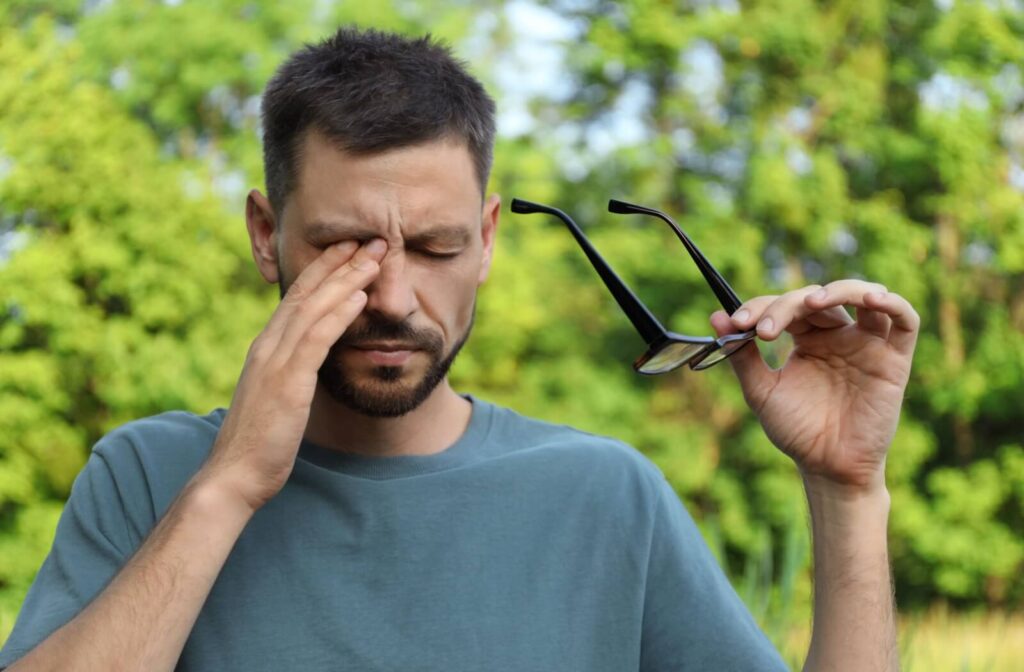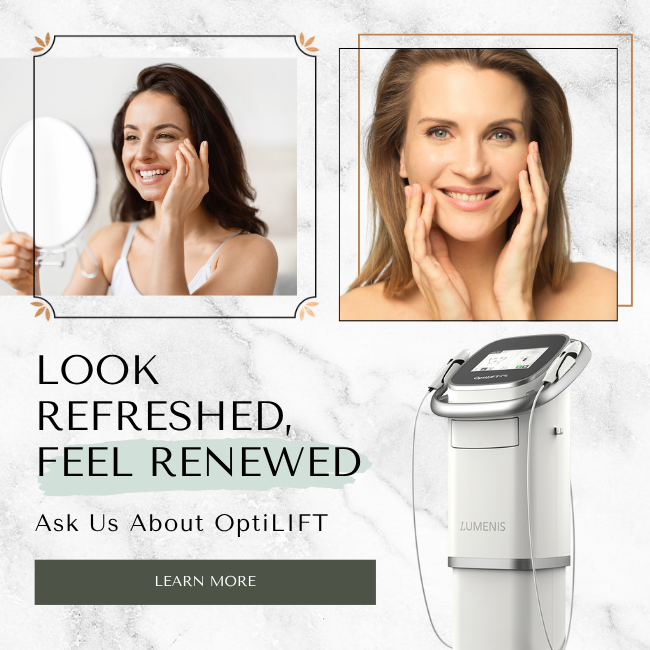The changing of seasons can feel refreshing. Crisp, wet mornings bring bountiful blooms, but for many people, the beauty of this transition feels bittersweet. The reason? Seasonal allergies.
The sneezing, congestion, and itchy, watery eyes that come with an allergic reaction turn a pleasant day into an uncomfortable battle. Here’s something that might surprise you: those same allergies that make your eyes watery and irritated can also leave them feeling dry, gritty, and uncomfortable. Allergies can absolutely contribute to dry eye symptoms.
Your road to dry eye relief might include allergy management and prevention. When allergies strike, and your irritating symptoms persist, it’s time to visit our team for a dry eye consultation.
Allergies & Your Eyes
The human body is an open system that constantly responds to its environment. Take allergies, for example.
When you have allergies, your immune system overreacts to harmless substances like pollen, dust mites, or pet dander. This reaction triggers the release of histamine and other inflammatory chemicals that cause the classic allergy symptoms we all know: sneezing, congestion, and yes, eye problems.
Your eyes are particularly vulnerable to allergens because they’re directly exposed to the environment. When allergens come into contact with your eyes, they can cause:
- Itching and burning sensations
- Redness and swelling
- Excessive tearing
- A feeling of grittiness or irritation
But here’s where it gets interesting. While allergies often cause watery eyes initially, they can actually contribute to dry eye problems over time.
The Dry Eye Connection: The Role of Allergies
Here’s a closer look at how allergies contribute to dry eye disease, a chronic condition that affects the health of your tear film.
The Quality vs. Quantity Problem
Your tears aren’t just water—they’re a complex balance of oils, proteins, and mucus that work together to keep your eyes comfortable, protected, and healthy.
There are 3 layers of a healthy tear film:
- An outer oil layer that prevents evaporation
- A middle water layer that provides moisture
- An inner mucus layer that helps tears stick to your eye
When allergies strike, the inflammation they cause can disrupt this delicate balance. While your eyes might produce more tears in response to irritation, these tears are often of poor quality and therefore do little to relieve your dry eye.
Inflammation Disrupts Normal Function
Allergic reactions cause inflammation of the conjunctiva (the clear membrane covering your eye) and the eyelids. This can damage the tiny meibomian glands that produce the oil layer of your tears. When these glands don’t work properly, your tears evaporate too quickly, leaving your eyes feeling dry despite having plenty of tears.
The inflammation also affects the cells that produce mucus for your tear film. Without enough mucus, tears don’t spread evenly across your eye surface, creating dry spots.
The Rubbing Factor
When allergies make your eyes itch, the natural response is to rub them. Unfortunately, rubbing can worsen both the allergic reaction and dry eye symptoms by introducing more allergens to your eyes. This increases inflammation, and can damage the delicate structures of your eyelids and tear glands.
While rubbing your eyes might provide temporary relief, it’s a bad habit you should try to avoid altogether. Trust us, it does more harm than good.

Are Antihistamines Making Your Dry Eyes Worse?
When allergies strike, many people reach for antihistamines. These medications can provide significant relief from sneezing, congestion, and itchy eyes. However, they can sometimes create a new problem: worsening dry eye symptoms.
How Antihistamines Affect Tear Production
Antihistamines work by blocking histamine receptors throughout your body. This reduces allergic reactions, but both oral medications and allergy eye drops can also have unintended effects on your eyes. Both of these treatments reduce overall tear production, which can lead to an ongoing cycle of dryness and irritation.
This doesn’t mean you should avoid antihistamines if you need them. The key is finding the right balance instead of becoming reliant on a single solution. Try:
- Restoring hydration with preservative-free artificial tears.
- Asking your eye doctor about switching to allergy eye drops with fewer side effects.
Allergy-Related Dry Eye: Prevention
Sometimes, prevention is much easier than finding a cure. When possible, reducing your exposure to allergens is a sure-fire way to minimize both allergic reactions and dry eye symptoms.
Environmental Controls
Start by creating an environment that’s friendlier to your eyes:
- Keep windows closed during high pollen days.
- Use a humidifier to maintain comfortable moisture levels.
- Wash bedding in hot water weekly to reduce dust mites.
Eye-Specific Prevention
Take extra steps to protect your eyes directly:
- Wear wraparound sunglasses when outdoors to block allergens.
- Avoid rubbing your eyes, even when they itch.
- Remove contact lenses during high allergy periods if they increase irritation.
- Use preservative-free artificial tears proactively, not just when symptoms appear.
Timing Matters
Understanding when allergens are highest can help you plan activities and treatments:
- Pollen counts are typically highest in the early morning and evening.
- Stay indoors when possible during peak allergy times.
- Shower and change clothes after spending time outdoors.
Allergy-Related Dry Eye: Management
When prevention isn’t enough, there are several effective treatment options for managing allergies and dry eyes simultaneously.
- OptiLight by Lumenis: This treatment uses intense pulsed light therapy to reduce inflammation and improve tear gland function.
- Prescription eye drops: Medications that can reduce inflammation and increase tear production.
- Warm compresses: Simple but effective for improving oil gland function.
- Preservative-free artificial tears: add moisture and hydrate the eyes. Avoid using anti-redness drops, which can contribute to dryness.
If persistent symptoms are making your life difficult, it’s time to visit our Windsor Eye Care team for a thorough evaluation.
Taking Control of Your Eye Comfort
Allergies and dry eyes don’t have to control your life. Once you understand the connection between these two conditions, it becomes easier to take proactive measures to prevent and manage future flare-ups and discomfort.
If you’re struggling with allergy-related dry eyes, don’t wait for symptoms to worsen. Connect with our Windsor Eye Care team to book an appointment. The road to lasting relief is closer than you think.





